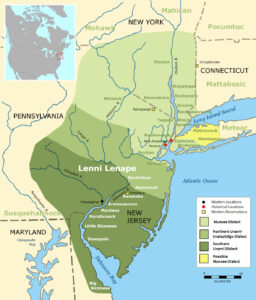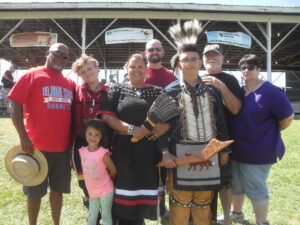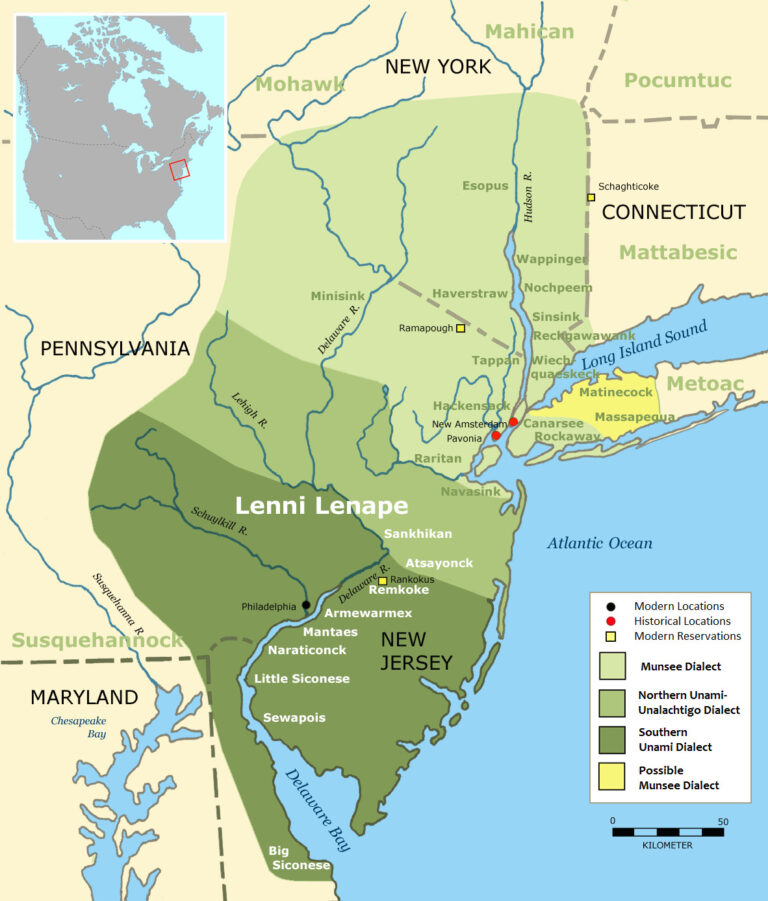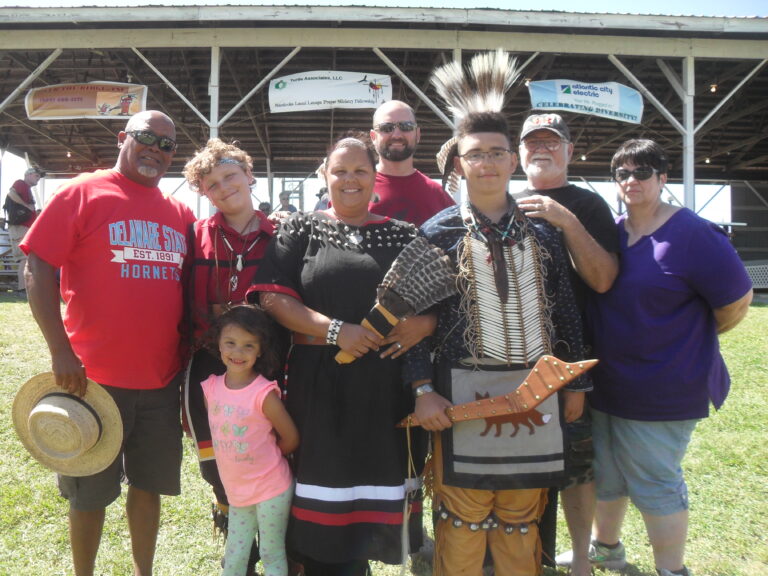Lenape People (Continuing Presence)
Essay
As the original inhabitants of Pennsylvania, Delaware, New York, and New Jersey, the Lenape people have maintained an enduring presence in the region and a role in its development and heritage. Despite displacements through coercion and force during the nineteenth century, Lenape people remained in the Delaware Valley. Many hid their ancestry and embraced Anglo-American identities until the twentieth century, when groups emerged in southeastern Pennsylvania, Delaware, and New Jersey to continue tribal traditions through education and cultural preservation.

Prior to European colonization, Lenape territory (the Lenapehoking) encompassed the areas of later New York City, western Connecticut, southern New York, Philadelphia, the Poconos, the Lehigh and Delaware Valleys, the entirety of New Jersey, and eastern Delaware (as well the land along the western bank of the Delaware River and Bay from the Poconos to at least Cape Henlopen). From the moment of first contact with Europeans in the sixteenth century, the Lenape engaged in cultural and commercial exchanges with European colonists in the Lenapehoking (colonists included Swedes, Finns, Quakers, the Dutch, the French, the English, Germans, and other Europeans). While influential in the region throughout the sixteenth, seventeenth, and eighteenth centuries, under the pressure of European settlement Lenape peoples faced removal to the western United States or Eastern Canada. Among the latest removals were the Lenape of Brotherton, New Jersey, who sold their lands to the state in December 1801 and relocated to areas near Oneida Lake in New York (in 1832, they sold their remaining hunting and fishing rights).
Lenape descendants remained in the region in various small communities, but records of their lives and public presence in the nineteenth century are rare. In New Jersey, records document Lenape children who served as indentured servants to white merchants and farmers. Lenape existence remained somewhat obscure to non-Native people until the middle of the twentieth century. Then, on the heels of the civil rights movement and influenced by the American Indian Movement (AIM), Lenape peoples of the Greater Philadelphia region pursued greater self-determination, seeking to exercise their right to define their own identities and cultural expression. The many groups that formed in Pennsylvania, New Jersey, and Delaware included the Nanticoke Lenni Lenape (NLL), which became a formal entity on August 7, 1978 (New Jersey state recognition granted in 1982), and the Lenape Nation of Pennsylvania (LNPA), which formed in the 1990s.
Hosting Traditional Ceremonies
Among the numerous groups in eastern Pennsylvania, southern New York, southern New Jersey, and northern Delaware, the LNPA became one of the most active. While neither a federally recognized nor a state-recognized tribe (Pennsylvania did not have an office of Indian affairs or any process of state recognition), the organization gained 501(c)(3) status in 2001. Headquartered in Easton, Pennsylvania, the LNPA hosted traditional ceremonies, maintained a cultural heritage center and museum, organized Lenape language education programs, and engaged in community service. The group sought to explain Indigenous history and assert that the original inhabitants of Pennsylvania did not simply disappear in the face of aggressive European-American expansion. Its activities included a quadrennial “Rising Nation River Journey” trip down the length of the Delaware River (from Hancock, New York, to Cape May, New Jersey), which had a mission of signing new treaties of friendship and brotherhood with local churches, educational institutions, environmental preservation groups, and historical societies. This activity sought to continue traditions of goodwill that began with meetings and treaties between William Penn (1644-1718) and Chief Tamanend (c. 1625-1701) in the 1680s. The LNPA also initiated yearly friendship treaty signings at Temple University and other Philadelphia-region universities. Close ties with Temple also resulted in a celebration of Indigenous Peoples Day on October 14, 2019. The LNPA’s relationship with the Tri-College Consortium (Haverford, Bryn Mawr, and Swarthmore Colleges) culminated in the offering of Lenape language classes at Swarthmore and presentations, conferences, and other events at Haverford and Bryn Mawr.

The Nanticoke Lenni Lenape maintained a strong presence in southern New Jersey. Centered in Bridgeton, they became one of the state’s three recognized tribes (which also included Ramapough Lenape Indian Nation of Mahwah, Bergen County, and the Powhatan Renape of Rancocas, Burlington County). The NLL, formed in the 1970s and recognized by the state in 1982, took a confederated approach to the process of recognition with members from various Nanticoke and Lenape groups. Led by Mark “Quiet Hawk” Gould (b. c.1942), the group sought to unite the Indigenous community within southern New Jersey and further assert indigenous identity in their historical homeland. The tribe held multiple gatherings, participated in community outreach programs in Bridgeton and Philadelphia, and worked alongside other Lenape and Nanticoke entities within the region.
A Historically Native American Church
Among the most vibrant Indigenous groups in the region, in 1995 the NLL community resecured their tribal grounds in Fairton, New Jersey. Their church, Saint John United Methodist Church (UMC) in Fordville, was designated a historically Native American church by the New Jersey annual conference of the UMC. This led to similar recognition by the national General Conference of the Methodist Church in 2017. During the 2020 Coronavirus pandemic, members of the church and NLL provided food and relief to the community (especially in Fairfield Township).
Together with the Nanticoke Tribe of Delaware and the Lenape Indian Tribe of Delaware, the Nanticoke Lenni Lenape formed the Confederation of Sovereign Nentego-Lenape Tribes on May 20, 2007. Akin to the NLL, the Nanticoke Tribe of Delaware, based in Sussex County, and the Lenape Indian Tribe of Delaware, in the Dover area, also sought to preserve the region’s Lenape heritage. Both tribes were state-recognized entities. The Nanticoke of Delaware maintained a museum and cultural center in Millsboro, Delaware. Both Delaware groups participated in powwows, helped maintain the confederation’s online museum, and fostered community among Indigenous peoples of the region.
Descendants of the original inhabitants of the greater Philadelphia region persisted despite the ravages of colonization and forced assimilation. Their resilience was a testament to the strength of their ancestors, and their efforts in education and community outreach had an enduring effect on the region and its citizens. By preserving their culture, these groups ensured the Lenapes’ place in the history of the region and its future.
Matthew Soderblom is a Ph.D. student at Temple University, where he specializes in nineteenth-century American literature and frontier literature. His research interests include Indigenous and American immigrant literatures. He is currently working on a project involving the works of Willa Cather, Zitkalá-Šá, and O.E. Rølvaag. (Author information current at time of publication.)
Copyright 2023, Rutgers University

